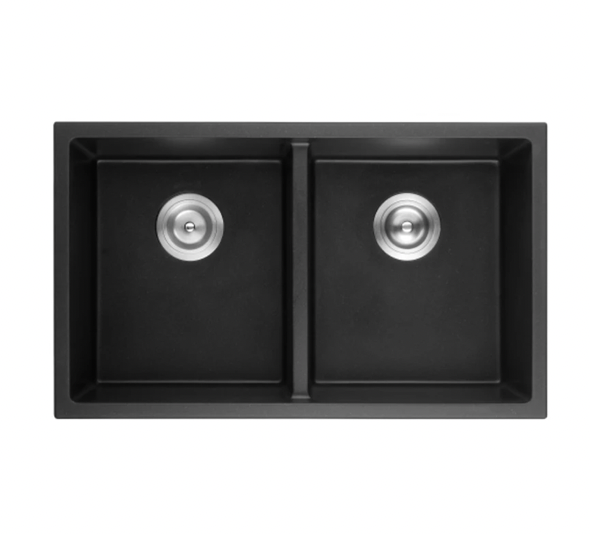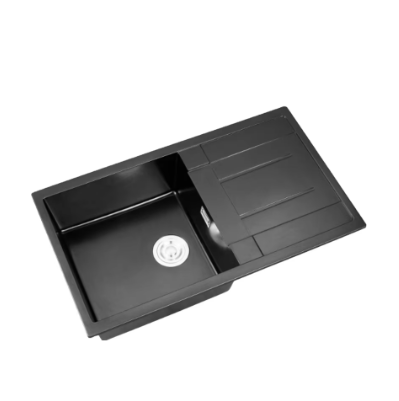Compreensão Pia de Granito Composição do material
Pias de Granito Natural vs. Composto
Pias de granito natural são cortadas em pedra natural e têm uma aparência completamente natural e clássica de pedra. Essas pias apresentam a beleza e tons naturais do granito, que são misturados com uma resina acrílica que dá à pia um acabamento brilhante. Por outro lado, as pias de granito composto são feitas de uma mistura de pedra triturada e resinas acrílicas, e têm uma aparência mais consistente. Este material sintético é resistente a rachaduras e replica o visual exclusivo do granito enquanto adiciona uma força inigualável e facilidade de limpeza! Em termos de aparência, as pias de granito natural têm designs complexos e únicos próprios, enquanto as pias compostas têm um visual mais acabado. A manutenção também é diferente, com as pias de granito natural precisando ser seladas regularmente, enquanto as de variedade composta não precisam. Em termos de custo, as pias compostas são mais baratas e mais fáceis de instalar. Uma pesquisa de 2010 mostrou que mais de 60% dos consumidores preferem uma pia de granito composto, pois é mais fácil de manter e tem melhor aparência do que o granito natural, já que sempre será a mesma.
Propriedades Principais: Durabilidade e Resistência ao Calor
O granito é durável, por isso as pias de granito são algumas das mais populares na cozinha. Seu material durável impede que ela se rache facilmente com uso intensivo. O granito também resiste ao calor quando usado na cozinha, resistindo até mesmo ao dano causado por panelas e frigideiras quentes. Estudos da indústria mostraram que as pias de granito podem suportar calor até 536°F (280°C), permitindo que você mova diretamente do fogão para a pia com facilidade. Aprovado pelos especialistas, essa durabilidade aliada à resistência ao calor faz das pias de granito um investimento que passará pelo teste do tempo em qualquer cozinha.
Superfícies Não Porosas para Higiene
As pias de granito também proporcionam um ambiente de cozinha higiênico devido à natureza não porosa do material, que impede o crescimento de bactérias e mofo. Superfícies não porosas (como as pias de granito) por natureza não permitem que bactérias cresçam em pequenas fendas, ao contrário das superfícies porosas propensas a bactérias. Estudos estatísticos de higiene demonstram que materiais não porosos reduzem os níveis de bactérias em 80% em comparação com superfícies porosas. A higiene é de suma importância na preparação de alimentos e nas pias de granito, uma superfície fácil de limpar que garante os mais altos níveis de higiene.
Avaliando Suas Necessidades e Padrões de Uso da Cozinha
Funcionalidade de Bacia Única vs. Dupla Bacia
A decisão entre uma pia de um ou dois bacias depende em grande parte do seu estilo de cozinhar e das necessidades da sua casa. Pias com uma única bacia são especialmente projetadas para panelas maiores e talheres grandes, ideais para quem gosta de cozinhar refeições abundantes ou receber amigos. Enquanto isso, as pias de duas bacias oferecem flexibilidade, permitindo que você facilmente multiplique tarefas, como lavar louça em uma bacia enquanto molha e prepara legumes na outra. As pias de duas bacias são muito apreciadas pelas famílias, pois ajudam a criar um sistema para suas tarefas, otimizando o tempo que passam na cozinha. Feedbacks dos consumidores indicam que a escolha entre a configuração de uma ou duas bacias pode variar, e os desejos e necessidades de cada pessoa também terão um papel importante na determinação de qual é a melhor opção.
Profundidade Ótima da Pia para Tarefas Diárias
A profundidade da pia tem um grande impacto na forma como você pode usar uma pia de cozinha, desde a lavagem de panelas grandes até encher jarros com água. As profundidades padrão das pias estão disponíveis entre 8 e 10 polegadas e são adequadas para a maioria das pessoas segundo estudos ergonômicos. Chefs profissionais tendem a preferir pias mais profundas devido às suas propriedades anti-atingidamento e à capacidade de armazenar tudo o que é necessário de uma só vez, facilitando as tarefas na cozinha. Portanto, ao escolher uma pia, certifique-se de encontrar a profundidade que melhor se adapta às suas atividades diárias na cozinha para obter tanto uso prático quanto confortável.
Adaptando o Tamanho da Pia às Dimensões do Armário
Quando se trata de instalar uma nova pia, o dimensionamento correto é essencial para um encaixe perfeito com as medidas do armário. Quando você escolhe uma pia do tamanho errado, pode ser difícil instalá-la e ela parecerá deslocada no seu banheiro. As dimensões normais das pias geralmente correspondem a armários padrão, que variam de 30 a 36 polegadas de largura. Você precisa ter certeza de que deixou espaço suficiente para os acessórios de fixação e conexões de encanamento. Situações de mau encaixe, como uma pia sob a qual você pode ver parte do balcão ou uma com pouca ou nenhuma suporte na borda, podem comprometer a coesão do design da sua cozinha. Então, o antigo ditado de medir duas vezes, cortar uma vez e ouvir o que os profissionais aconselham, pode ajudar a garantir que você não caia em nenhum problema de reforma.
Escolhendo o Estilo de Instalação Certo
Submontagem vs. Montagem Superior: Prós e Contras
Ao escolher o tipo de instalação da pia de cozinha, tanto o estilo embutido quanto o estilo sobreposto têm seu próprio valor estético e funcional. As "pias embutidas" são montadas abaixo da bancada, expondo a borda do balcão, e são fixadas por baixo com parafusos, um detalhe pequeno, mas que resulta em uma aparência muito elegante e permite que o balcão seja limpo com mais facilidade. As pias sobrepostas, também chamadas de drop-ins, descansam sobre a bancada, então geralmente são mais econômicas e fáceis de instalar.
- Vantagens das Pias Embutidas : Elas oferecem uma aparência contínua, são fáceis de limpar e combinam bem com bancadas de granito.
- Desvantagens das Pias Embutidas : A instalação pode ser complexa e pode exigir assistência profissional, muitas vezes levando a custos mais altos.
- Vantagens das Pias Sobrepostas : Essas pias são fáceis de instalar e substituir, tornando-as ideais para proprietários preocupados com o orçamento.
- Desvantagens das Pias Sobrepostas : Eles podem acumular sujeira ao longo da borda e alterar as linhas limpas da bancada.
Os dados do mercado sugerem que pias submetidas estão ganhando popularidade entre os proprietários devido aos seus benefícios estéticos e compatibilidade com designs de cozinha contemporâneos.
Considerações sobre Pias Rústicas
Pias rústicas, também conhecidas como pias de frente de avental, ganharam popularidade por seu estilo rústico chic e confiabilidade. Seus recipientes profundos podem acomodar panelas e frigideiras grandes, o que as torna uma escolha popular para chefs sérios. Embora sejam visualmente impressionantes, a adição de uma pia rústica pode significar uma alteração na altura e no layout da bancada, o que pode não ser ideal para um espaço de cozinha.
- Atração visual : As pias rústicas oferecem um ponto focal único que complementa tanto estéticas de cozinhas tradicionais quanto modernas.
- Logística de Instalação : Requer planejamento cuidadoso para acomodar a profundidade e o peso da pia, às vezes exigindo armários personalizados e suporte para o design pesado de frente de avental.
Por exemplo, cozinhas com pias de granja geralmente se integram ao armazenamento e superfícies de trabalho para criar uma aparência coesa, equilibrando o peso e a profundidade com um design robusto e funcional.
Compatibilidade com as bordas das bancadas
DIFERENTES SUPERFÍCIES DE TRABALHO Ao decidir sobre a instalação da pia, tenha em mente como a escolha da pia será afetada pelas opções de borda da bancada. Diversas bordas de superfície de trabalho, como chanfradas ou arredondadas, afetarão como a pia pode se encaixar de forma suave no ambiente da cozinha. **Fãs do Under mount** e bordas polidas apreciarão a transição suave da bancada para a pia, enquanto os **Fãs do Top mount** trabalham essa pedicura fluente, certamente, até a borda chanfrada visível do acabamento superior que é perceptível aos humanos.
- Estilos de Borda de Bancada : Os designers geralmente recomendam bordas polidas para um visual contínuo com as pias sob a bancada, enquanto bordas chanfradas complementam os designs de pias superiores.
Do ponto de vista dos designers, combinar aberturas para a pia com o estilo do balcão é essencial. Através de uma seleção cuidadosa, os proprietários podem garantir que sua pia esteja alinhada tanto com a praticidade quanto com a aparência desejada para a cozinha, melhorando a coesão geral do design e a funcionalidade.
Avaliações de Resistência a Manchas e Riscos
Quando você decide qual tipo de pia de cozinha seria a melhor escolha para sua cozinha, você pensa na resistência a manchas e riscos, pois é um produto que é usado diariamente. Pias de granito geralmente são testadas com alguns parâmetros de qualidade para verificar sua resistência a riscos, manchas etc. Esses testes muitas vezes são realizados aplicando agentes manchadores e materiais abrasivos na superfície da pia e testando a resistência. A resistência varia de acordo com a composição mineral do granito. Um teor mais alto de quartzo, por exemplo, significa que ela tende a ser mais resistente a riscos. Profissionais da construção dizem que o conhecimento dessas classificações é importante para aqueles que projetam para durabilidade em casa na cozinha. De acordo com especialistas da indústria, 'Uma pia que se saiu bem nos testes mantém sua beleza ao longo do tempo, mesmo após o uso diário.'
Tolerância ao calor para necessidades de cozimento
A resistência ao calor de uma pia de granito deve ser avaliada para merecer a atenção dos chefs de cozinha que lidam com panelas quentes. Pias de granito composto também são resistentes ao queimado e podem suportar calor até 500°F sem consequências, como deformação ou dano. Este benefício adicional significa que quando você colocar uma panela ou pot muito quente na pia para esfriar, não precisará se preocupar com o material sofrendo choque térmico. Guias de comparação mostram que as pias de aço inoxidável esfriam rapidamente, mas às vezes podem se deformar ou ficar manchadas sob temperaturas extremamente altas. A propósito, os amantes da cozinha podem atestar que as pias de granito não são fáceis de danificar; elas podem ser fabricadas para se adaptar aos hábitos de cozinhar do usuário sem perder sua força, o que naturalmente se traduz em sua funcionalidade em uma cozinha louca e movimentada.
Requisitos de Limpeza para Longevidade
As pias de granito durarão e terão uma boa aparência desde que você as limpe e mantenha corretamente. O ideal é limpar a superfície com apenas uma gota de sabão para pratos e um pano macio para protegê-la contra qualquer dano abrasivo. O uso desses produtos regularmente manterá a pia como nova, evitando manchas d'água e depósitos minerais. A falha em mantê-la pode resultar em manchas e no desbotamento do brilho natural da pia ao longo do tempo. Em um estudo conduzido pela National Sanitation Foundation, a limpeza regular pode ajudar a garantir a vida útil de um eletrodoméstico da cozinha (aqueles que foram bem cuidados duraram até 15 anos a mais do que aqueles que não foram). É por isso que manter um cronograma disciplinado de limpeza é necessário para manter sua pia de granito funcional e, claro, continuar bonita!

Planejamento Orçamentário e Custo-Benefício
Faixas de Preço por Qualidade do Material
É importante conhecer os preços das pias de granito para fazer o orçamento de acordo. As pias de granito composto geralmente custam entre $400 e $2000 ou mais, sendo que a configuração da bacia é um dos fatores que afetam o preço. Uma pia de granito geralmente custa entre $400 e $1500 para um modelo de uma bacia só, com modelos de alta gama saindo por mais do que isso. Opções de duas bacias variam de $600 no lado mais barato até $2000, enquanto as pias de estilo farmhouse normalmente começam em $800 e podem chegar a $2000. É evidente que a qualidade do item e a complexidade do design têm muito a ver com o custo. Uma pia de granito de qualidade pode ser um investimento com a aplicação prática que oferece para sua cozinha; ela também é um acessório que tem grande impacto visual, e em muitos casos pode ser uma adição essencial para aperfeiçoar sua cozinha.
Equilibrar Custos Iniciais com Valor de Longo Prazo
Leve em consideração o custo inicial e o valor a longo prazo ao fazer orçamento para uma pia de granito. A Canon Cable ID printer fornece o custo total de propriedade, incluindo o investimento inicial, instalação e manutenção rotineira. Embora sejam um pouco mais caras do que outros tipos de pias no início, sua longevidade e baixo custo de substituição permitem economizar no final. O conselho inteligente dirá para optar por materiais duráveis, como o granito compósito, que amortizará despesas ao longo do tempo, apesar do custo. Ao escolher o equipamento de cozinha certo, como eletrodomésticos, acessórios e outros elementos-chave de design, você poderá aproveitar sua cozinha da melhor maneira possível - e qualquer tempo livre que sobrar poderá ser aproveitado em um ambiente atraente, refinado e bem organizado.
Garantia e Suporte do Fabricante
É aconselhável considerar garantias e suporte do fabricante ao comprar pias de cozinha. Uma boa garantia pode oferecer alívio contra defeitos ou danos que podem ocorrer. Procure por um suporte completo do fabricante, que pode incluir ajuda ao serviço ao cliente, peças de reposição e conselhos de manutenção. Ler avaliações e comentários sobre fabricantes poderia ajudá-lo a determinar a confiabilidade com confiança. Um fabricante bem avaliado tende a oferecer produtos de alta qualidade e excelente suporte ao cliente, para que você possa adquirir tais equipamentos inteligentes para a cozinha.
Perguntas Frequentes
Qual é a principal diferença entre pias de granito natural e compósito?
Pias de granito natural são esculpidas em pedra extraída de pedreiras, oferecendo padrões únicos, enquanto pias de granito compósito são feitas de uma mistura de pedra triturada e resinas de acrílico, proporcionando uma cor e aparência consistentes.
Quão duráveis são as pias de granito?
Pias de granito são altamente duráveis, resistentes a rachaduras e lascas, e podem suportar altas temperaturas até 536°F (280°C), tornando-as ideais para uso pesado na cozinha.
As pias de granito exigem muita manutenção?
Pias de granito natural precisam ser seladas com frequência, enquanto as pias de granito composto são mais fáceis de manter. A limpeza regular com sabão neutro e um pano macio ajuda a preservar sua aparência e longevidade.
Quais são os benefícios das pias sobremontadas?
Pias sobremontadas oferecem uma aparência contínua e facilitam a limpeza, pois os detritos podem ser varridos diretamente para a pia. No entanto, podem exigir instalação profissional, o que resulta em custos de instalação mais altos.
Por que devo considerar uma pia de fazenda?
Pias de fazenda são práticas para lidar com panelas e frigideiras grandes e oferecem um charme rústico. Elas podem exigir ajustes na altura da bancada e armários personalizados para acomodar sua profundidade e peso.



